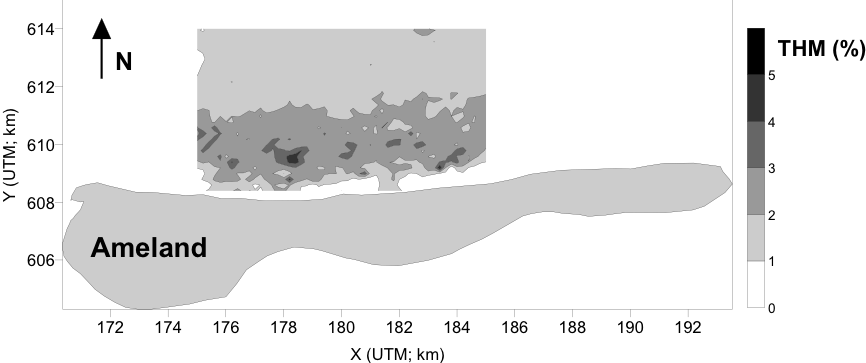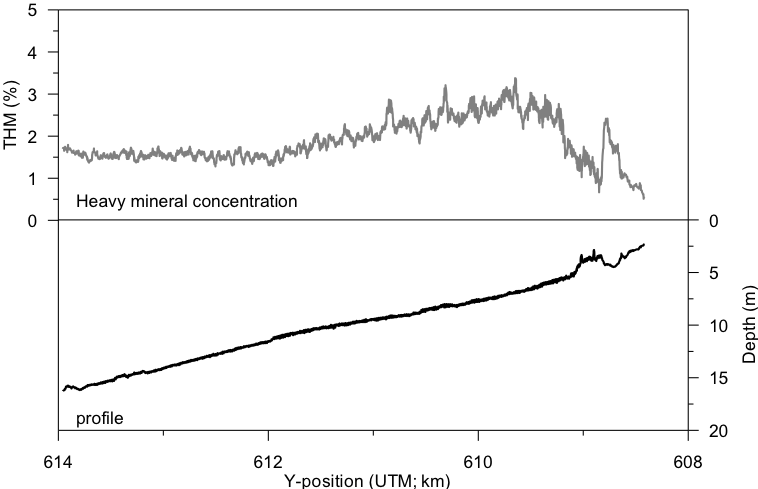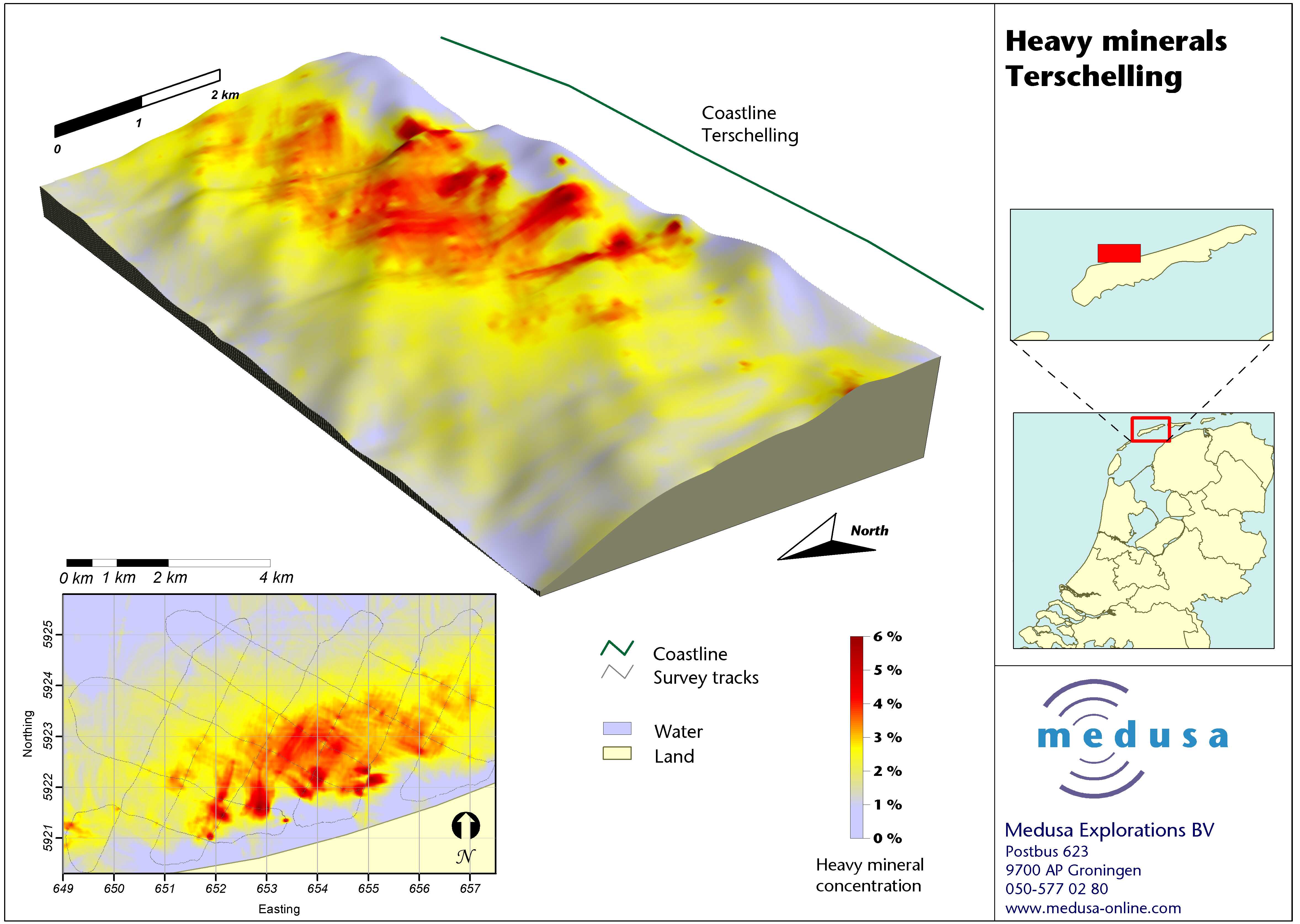Heavy mineral placers
Measuring heavy minerals
Coastal sediments are mainly composed of terrigeneous clastic grains, commonly referred to as sand. These sands are fragments of rocks or minerals derived by physical or chemical breakdown of the source rock. Every near surface rock or outcrop is a potential source of such grains. The chemical and physical weathering processes that act on these outcrops will generate rock fragments that are further broken down during transport by gravity, water, wind and ice. These changes are particularly effective on “soft” minerals as plagioclase and K-feldspar ((K,Na,Ca)[AlSi3O8]) and to a lesser extent, quartz (SiO2). The resulting sediments can have a large range of grain sizes.
Heavy minerals are minerals that have densities larger than quartz (>2.65 kg l-1). They occur only in small amounts in the source rock and consist of crystals like zircon (ZrSiO4), monazite ((Ce,La,Th)[PO4]) and garnet ((Mg,Fe,Mn,Ca)[Al2Si3O12]). The heavy minerals have in common that, besides their large density, they are more resistant to weathering than soft minerals and can therefore be concentrated in the sediment during a sedimentary cycle. The finest fraction of the soft minerals is easily transformed in clay minerals, but the more resistant heavy-mineral fraction becomes mainly concentrated in the finer sand fraction.
Heavy minerals often have appreciable amounts of U and Th included in their crystalline structure, whilst these two elements are almost absent in light minerals. Since the radionuclides 238U and 232Th are radioactive, measurements of decay properties can be used to determine the concentration of those heavy minerals with respect to light minerals (see e.g. de Meijer, 1998). By measuring the concentrations of radionuclides in the field, the heavy mineral fraction can be determined.

Typical concentrations of radionuclides for various type of minerals (from de Meijer, 1998)
Sorting of heavy minerals along the coastline
Due to their larger density, heavy minerals are concentrated along the coastline. Locally, heavy minerals in Dutch beach sands can be concentrated up to ~30% (Schuiling et al., 1985) but the total mean concentration of heavy minerals in Dutch beach sands is low (~1%).
In 1992, large concentrations of heavy minerals were found on the beach of the Dutch island of Ameland. This >4 km long, 100 m wide heavy-mineral placer was deposited after a period of storms, had a thickness of about 1 m and consisted of >30% heavy minerals (by weight). The presence of such heavy-mineral concentrations has not been noticed before and led to the question where the heavy minerals came from. Mass balance calculations and sample analysis from the dune sands proved that only a small amount (~10%) of heavy minerals could be attributed to lag deposit formation from eroded dune sands. As a consequence it was concluded that the heavy minerals were deposited from off-shore locations. To investigate this hypothesis, a tool for the prospecting of heavy minerals underwater, an underwater gamma-ray spectrometer, was developed (de Meijer, 1998). With this system, the concentration of heavy minerals is determined by radiometric mapping of the seafloor. In 1994 and 1995 surveys were conducted in the coastal waters of the island. The results of the 1994 campaign are plotted in the figures below and reveal an increased concentration of heavy minerals, uniform in long-shore direction, at around 4 m and 7 m water depth. The averaged cross-shore results show the location of the breaker bar system at y-position 609 km and indicates that heavy minerals are concentrated at two locations: just landward of the breaker bar in the inner surf zone and seaward of the breaker bar on the lower shoreface. The presence of these heavy-mineral concentrates off-shore led to the tentative conclusion that these offshore concentrates are transported as a sludge towards the beach and deposited as storm deposits, similar to the reasoning of Stapor (1973). The off-shore heavy-mineral concentrates were also determined in a successive measuring campaign off Ameland in 1995. This led to the conclusion that these placers are probably actively formed and are not the result of one major (storm) event. The subsequent studies by Tánczos (1996) showed that asymmetric wave motion (e.g. by wave shoaling) can be an important process in the formation of placers. These placers can be formed actively, in contrast to the overall assumption that heavy-mineral concentrations form passively as a lag deposit by the selective removal of light minerals.
The sedimentary behavior of heavy minerals in a coastal system is described in the PHD project of Koomans.

Total heavy-mineral concentration (THM) off the coast of the Dutch island Ameland

Averaged cross-shore transect of profile and heavy-mineral concentration off the coast of Ameland.
Another mapping project revealed similar distribution patterns of heavy mineral placers along the beach of Terschelling.

Heavy mineral content off the beach of Terschelling, the Netherlands
Mining of heavy minerals
Many heavy minerals contain valuable elements and also diamonds are considered a heavy mineral. In several countries, mining of these sediments is a major contributor to the national economy and exploration of heavy minerals in recent or fossil placers, is an important issue. The economic value of heavy-mineral concentrations depends on the composition and accessibility of the heavy mineral placers. The studies presented show that sorting of heavy minerals occurs mainly in two regions along the coastal profile. In both regions different sedimentary processes are involved (Koomans, 2004).
One of the locations of placer formation is in the region of closure depth. Even when only low concentrations of heavy minerals are present in the original sediment, selective sediment-transport processes will concentrate the heavy minerals. The fact that these placers are located around the 25-years depth of closure indicates that sorting processes are relatively slow. When these sediments are mined, it will take several years, depending on wave climate and morphology, before new concentrations have developed.
Heavy minerals can also be formed in the inner surf zone. These accumulations develop fast, within several hours. Therefore, the inner surf zone can be seen as a natural heavy-mineral plant, that continuously concentrates the valuable minerals. We can expect that by removing the upper layer of heavy minerals from the inner surf zone, sediments are sorted again and new placers will develop, until the bulk sediments in the inner surf zone are depleted in the heavy-mineral fraction (Koomans, 2000).
In developing a mining strategy, we can consider these differences in sorting processes, although other parameters are, of course, also important in the strategy of mining. The rough conditions in the inner surf zone and the long distance between the depth of closure region and the mainland should also be considered, but knowledge on the natural processes can be of importance. Heavy mineral concentrates in the region of the depth of closure can be mined only once. The time period for resilience is likely too long for a long-term mining programme. In the region of the inner surf zone, repeated mining can possible, provided that concentrations arte high enough, and natural processes can be used to pre-select the valuable minerals.
References
Koomans, R.L., 2000. Sand in motion: effects of density and grain size. RUG, Groningen.
